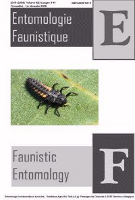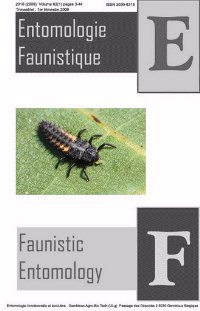- Startpagina tijdschrift
- Volume 71 (2018)
- Hydroptila lotensis Mosely 1930 and Tinodes maculicornis (Pictet 1834): two caddisflies new to the Grand Duchy of Luxembourg (Trichoptera: Hydroptilidae & Psychomyiidae)
Weergave(s): 2461 (50 ULiège)
Download(s): 267 (27 ULiège)
Hydroptila lotensis Mosely 1930 and Tinodes maculicornis (Pictet 1834): two caddisflies new to the Grand Duchy of Luxembourg (Trichoptera: Hydroptilidae & Psychomyiidae)

Nota's van de redactie
Reçu le 2 mars 2017, accepté le 1er août 2017
Résumé
Le 7.ix.2016, Tinodes maculicornis (Pictet 1834) a été capturé au piège lumineux à Remich au bord de la Moselle. Le 10.ix.2016, Hydroptila lotensis Mosely 1930 a été trouvé à Remerschen, aussi au bord de la Moselle. Les deux espèces sont nouvelles pour la faune du Grand Duché de Luxembourg
Abstract
On 7.ix.2016, Tinodes maculicornis (Pictet 1834) was captured with a light trap in Remich along the River Moselle. On 10.ix.2016, Hydroptila lotensis Mosely 1930 was found in Remerschen, also along the River Moselle. Both species are new to the fauna of the Grand Duchy of Luxembourg
Introduction
1Adult Hydroptilidae can be recognised by the pointed forewings, which are smaller than 5 mm. Their short antennae are maximum about half as long as their forewings, while in other families, these are about as long as the forewings or even longer. In contrast to most other caddisflies occurring in the Grand Duchy of Luxembourg, larvae of the genera Hydroptila, Oxyethira and Orthothrichia cannot yet be identified to species level. Their small size in combination with the lack of identification keys to identify the larvae renders this one of the least known caddisfly families. Also Psychomyiidae are quite small, with forewings of 3.5-8 mm. They possess 2, 4 and 4 spores on the tibia of the fore, middle and hind legs, respectively and they lack ocelli. Unfortunately, not all the species of the genus Tinodes can be identified with certainty based on morphological characteristics of the larvae (Waringer, personal communication). Here, Hydroptila lotensis Mosely 1930 and Tinodes maculicornis (Pictet 1834) are reported for the first time for the fauna of the Grand Duchy of Luxembourg.
Materials and Methods
2On 7.ix.2016, caddisflies were sampled with a light trap along the River Moselle in Remich (49°33’23”N, 6°22’54”E, 145 m a.s.l.) and on 10.ix.2016 in Remerschen (49°29’51”N, 6°21’59”E, 150 m a.s.l.). Species were identified using Malicky (1983) and for the Hydroptilidae also Marshall (1978) and Neu (2010). Material of Hydroptila lotensis and Tinodes maculicornis has been deposited to the collection of the Royal Belgian Institute of Natural Sciences.
Results
3One male of Tinodes maculicornis (Figure1)was sampled with a light trap in Remich along the River Moselle on 7.ix.2016, where also Glyphotaelius pellucidus (Retzius 1783), Hydropsyche exocellata Dufour 1841 and Oxyethira flavicornis Pictet 1834 were observed. Males of T. maculicornis can be recognised based on the shape of the genital appendages (Figure 2). Females can be identified based on the dark sinuous sclerotised posterior margin of sternite eight.


One female of Hydroptila lotensis (Figure 3) was sampled with a light trap along the River Moselle in Remerschen on 10.ix.2016, where also Agraylea multipunctata Curtis 1834, Agrypniavaria (Fabricius 1793), Ecnomus tenellus (Rambur 1842), Hydroptila forcipata (Eaton 1873), O. flavicornis and T. waeneri were observed. Males of H. lotensis can be identified based on the posterior margin of tergite ten, which has a slight median nick and the apices of the inferior appendages each possess a strong upturned pointed claw. Females have a deep and wide excision in tergite eight without marginal thickening (Figure 4), just like Hydroptila sparsa Curtis 1834. H. lotensis differs from the latter species by the lateral arms of the internal apparatus that extend beyond the median process (Figure 5) and the ventral mushroom-shaped ventral sclerite that has almost right-angled basal corners (Figure 6). In addition, H. lotensis differs from the other species from the H.sparsa-group by the presence of an indentation along the distal margin of segment eight (Figure 7).





Discussion
4Recently, caddisflies in the Grand Duchy of Luxembourg have mainly been studied in the context of water quality assessment and therefore, mostly larvae are observed (Dohet et al., 2008). It is therefore no surprise that species such as H. lotensis and T. maculicornis, of which larvae cannot be identified with certainty, were not yet observed in the Grand Duchy of Luxemburg (Schrankel et al., 2008). In addition, only catchments with a surface of more than 10 km² have to be monitored in the context of the European Water Framework Directive. It's therefore unlikely to capture T. maculicornis during water quality monitoring, since this species mainly inhabits small rivulets near the spring. On the other hand, H. lotensis inhabits very large river systems like the River Moselle, which are considered as heavily modified water bodies in the Grand Duchy of Luxembourg and are therefore not taken into account during the usual monitoring.
5Although Lock & Goethals (2012) reported Tinodes maculicornis from Belgium, all records concerned larvae, which cannot be identified with certainty based on morphological characteristics (Waringer, personal communication). At the locations where these larvae were captured, adults were searched and indeed only Tinodes assimilis McLachlan 1865 and Tinodes unicolor (Pictet 1834) were found and T. maculicornis was therefore removed from the Belgian checklist (Lock, 2015). However, one female of T. maculicornis was recently discovered along the river Meuse, the presence of this species in Belgium could thus be ascertained after all (Lock & Van Butsel, 2017). In Germany, the species was only observed in the southern federal states Bayern and Baden-Württemberg (Robert, 2001). In northern France, the species has been reported from the departments Ardennes, Meuse, Seine et Marne, Marne and Haute Marne (Coppa, 2016).
6Although T. maculicornis was captured along the River Moselle, which is a large river, the larvae live in very small streams near springs, where they live in hygropetic or madiculous habitats. The male that we captured almost certainly did not grow up in the River Moselle, but was probably a wandering specimen originating from a rivulet in the neighbourhood, which was attracted to the light. Hydroptila lotensis was already known from Belgium (Lock & Goethals, 2012). In northern France, the species has been found in the departments Aisne, Ardennes and Meuse (Coppa, 2016). In Germany, the species was previously only mentioned from Baden-Württemberg (Robert, 2001), but it also occurs in Rheinland-Pfalz (Neu, personal communication).
7Acknowledgements
8We would to thank Peter Neu for data about the distribution of Hydroptila lotensis and Tinodes maculicornis in Germany.
Bibliographie
Coppa G., 2016. Trichoptères: atlas de distribution des espèces. http://www.opiebenthos.fr/opie/insecte.ph, (16/02/2017).
Dohet A., Ferréol M., Cauchie H. & Hoffmann L., 2008. Caddisfly assemblages characterizing different ecological areas in Luxembourg: from geographical distributions to bioindication. Ferrantia, 55, 33-56.
Lock K., 2015. Eerste adulte Chaetopterygopsis maclachlani Stein 1874 gevonden in België. De Digitale Kokerjuffer, 18, 3-4.
Lock K. & Goethals P.L.M., 2012. Updated checklist of the Belgian caddisflies (Trichoptera). Bulletin de la Société royale belge d’Entomologique, 148(1), 27-32.
Lock K. & Van Butsel J., 2017. Hydroptila angulata Mosely, 1922, Hydroptila simulans Mosely, 1920 and Tinodes maculicornis (Pictet, 1834) confirmed for Belgium (Trichoptera: Hydroptilidae, Psychomyiidae). Bulletin de la Société royale belge d’Entomologique, 153(1), 32-35.
Malicky H., 1983. Atlas of European Trichoptera. Series Entomologica 24, Dr W. Junk Publishers, The Hague.
Marshall J.E., 1978. Trichoptera Hydroptilidae. Handbook for the Identification of British Insects, 1(14a), 1-31.
Neu P.J., 2010. Beitrag zur Unterscheidung der Weibchen der in Deutschland vorkommende Arten der Hydroptila sparsa-Gruppe (Trichoptera, Hydroptilidae). Lauterbornia, 71, 147-155.
Robert B., 2001. Verzeichnis der Köcherfliegen (Trichoptera) Deutschlands. Entomofauna Germanica, 5, 107-151.
Schrankel I., Neu P., Dohet A. & Schoos F., 2008. Checklist of the Trichoptera of the Grand Duchy of Luxembourg - First revision. Ferrantia, 55, 89-92.






